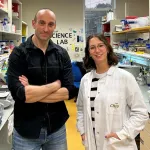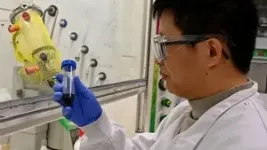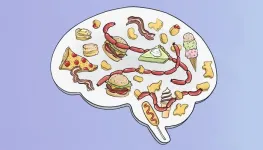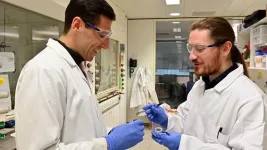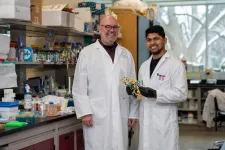(Press-News.org) Research conducted by the National Cancer Research Centre (CNIO), published today in ‘Nature’, reveals a mechanism in mice that is triggered just minutes after acute liver damage occurs.
This finding opens up avenues for future treatments of serious liver damage to include a diet enriched with the amino acid glutamate.
Glutamate supplementation can promote liver regeneration and benefit patients in recovery following hepatectomy or awaiting a transplant, the authors write in ‘Nature’.
Activating liver regeneration is key to treating diseases that involve severe liver damage, which are becoming increasingly frequent and are associated with poor dietary habits and alcohol consumption.
The liver is a vital organ, crucial to digestion, metabolism and the elimination of toxins. It has a unique ability, regeneration, which allows it to replace liver cells damaged by the very toxins that these cells eliminate. However, the liver stops regenerating in cases of diseases that involve chronic liver damage –such as cirrhosis–. Such diseases are becoming increasingly prevalent, associated with bad dietary habits and alcohol.
Learning to activate liver regeneration is therefore a priority today, to benefit mainly patients with severe liver damage and also those who have had part of their liver cut out to remove a tumour.
Research at the National Cancer Research Centre (CNIO), published today in Nature, has discovered in animal models a previously unknown mechanism of liver regeneration. It is a process that is triggered very quickly, just a few minutes after acute liver damage occurs, with the amino acid glutamate playing a key role.
The authors write in Nature that, in light of their results, nutritional glutamate supplementation can effectively promote liver regeneration and benefit patients with severe and chronic liver damage, such as those recovering after hepatectomy, to stimulate liver growth, or even those awaiting a transplant.
As explained by Nabil Djouder, head of the CNIO Growth Factors, Nutrients and Cancer Group and senior author of the study, “unhealthy diet and lifestyle can affect liver regeneration. Our results describe a fundamental and universal mechanism that allows the liver to regenerate after acute damage. These results may also help improve liver regenerative capacity in patients with severe liver damage, such as cirrhosis, or those who have undergone partial resection in surgery to remove a tumour.”
The first author of the paper is CNIO researcher María del Mar Rigual.
A “complex and ingenious” perspective on liver regeneration
Liver regeneration was known to occur through the proliferation of liver cells, known as hepatocytes. However, the molecular mechanisms involved were not fully understood. This current discovery is very novel, as it describes communication between two different organs, the liver and bone marrow, involving the immune system.
The results show that liver and bone marrow are interconnected by glutamate. After acute liver damage, liver cells, called hepatocytes, produce glutamate and send it into the bloodstream; through the blood, glutamate reaches the bone marrow, inside the bones, where it activates monocytes, a type of immune system cell. Monocytes then travel to the liver and along the way become macrophages – also immune cells. The presence of glutamate reprogrammes the metabolism of macrophages, and these consequently begin to secrete a growth factor that leads to an increase in hepatocyte production.
In other words, a rapid chain of events allows glutamate to trigger liver regeneration in just minutes, through changes in the macrophage metabolism. It is, says Djouder, “a new, complex and ingenious perspective on how the liver stimulates its own regeneration.”
A specific population of hepatocytes produces glutamate
The research also clarifies a previously unanswered question: how the various areas of the liver are coordinated during regeneration. In the liver, there are different types of hepatocytes, organised in different areas; the hepatocytes in each area perform specific metabolic functions. The study now published in Nature reveals that hepatocytes producing a protein known as glutamine synthetase, which regulates glutamate levels, play a key role in regeneration.
According to the CNIO group, when glutamine synthetase is inhibited, there is more glutamate in circulation, which accelerates liver regeneration. This is what happens when the liver suffers acute damage: glutamine synthase activity decreases, blood glutamate increases, and from there, the connection with the bone marrow is established, reprogramming macrophages and stimulating hepatocyte proliferation.
Possible therapeutic applications
The experiments have been carried out in animal models, but their results have been tested with bioinformatics tools, using databases of mouse and human hepatocytes.
According to Djouder, “dietary glutamate supplementation may simply be recommended in the future after liver extirpation, and also to reduce liver damage caused by cirrhosis, which is common in patients with poor diet or unhealthy lifestyle or other serious liver diseases.”
Rigual also suggests adding another goal for future research: “Exploring further the possibility of using glutamate supplements in humans who have undergone liver resection for tumour removal.”
Funding
This study has been financed with state public funds from the Spanish Department of Science, Innovation and Universities through the ‘Research Challenges’ programme, and private funds from Fundación BBVA and the Spanish Cancer Association (AECC).
END
Researchers have discovered a new mechanism for rapid liver regeneration triggered by glutamate
2025-03-26
ELSE PRESS RELEASES FROM THIS DATE:
Scientists discover why obesity takes away the pleasure of eating
2025-03-26
The pleasure we get from eating junk food — the dopamine rush from crunching down on salty, greasy French fries and a luscious burger — is often blamed as the cause of overeating and rising obesity rates in our society.
But a new study by scientists at the University of California, Berkeley, suggests that pleasure in eating, even eating junk food, is key for maintaining a healthy weight in a society that abounds with cheap, high-fat food.
Paradoxically, anecdotal evidence suggests that people with obesity may take less pleasure in eating than those of normal weight. Brain scans of obese individuals ...
How cells respond to stress is more nuanced than previously believed
2025-03-26
CLEVELAND—The body’s cells respond to stress—toxins, mutations, starvation or other assaults—by pausing normal functions to focus on conserving energy, repairing damaged components and boosting defenses.
If the stress is manageable, cells resume normal activity; if not, they self-destruct.
Scientists have believed for decades this response happens as a linear chain of events: sensors in the cell “sound an alarm” and modify a key protein, which then changes a second protein that slows or shuts down the cell’s normal function.
But in a new study published today in the journal Nature, researchers at Case Western Reserve University have discovered a ...
A new method to recycle fluoride from long-lived PFAS chemicals
2025-03-26
UNDER EMBARGO UNTIL: 16:00 GMT / 12 NOON ET WEDNESDAY 26 MARCH 2025
A new method to recycle fluoride from long-lived PFAS chemicals
Images available via the link in the notes section.
Oxford Chemistry researchers have developed a method to destroy fluorine-containing PFAS (sometimes labelled ‘forever chemicals’) while recovering their fluorine content for future use. The results have been published today (26 March 2025) in Nature.
PFAS – which stands for poly- and perfluoroalkylated substances – have been produced in large ...
A breakthrough moment: McMaster researchers discover new class of antibiotics
2025-03-26
The last time a new class of antibiotics reached the market was nearly three decades ago — but that could soon change, thanks to a discovery by researchers at McMaster University.
A team led by renowned researcher Gerry Wright has identified a strong candidate to challenge even some of the most drug-resistant bacteria on the planet: a new molecule called lariocidin. The findings were published in the journal Nature on March 26, 2025.
The discovery of the all-new class of antibiotics responds to a critical need for new antimicrobial ...
The devastating human impact on biodiversity
2025-03-26
Humans are having a highly detrimental impact on biodiversity worldwide. Not only is the number of species declining, but the composition of species communities is also changing. These are the findings of a study by Eawag and the University of Zurich published in the scientific journal Nature. It is one of the largest studies ever conducted on this topic.
Biological diversity is under threat. More and more plant and animal species are disappearing worldwide, and humans are responsible. Until now, however, there has been no synthesis of the extent of human intervention in nature and whether the effects can be found everywhere in the world ...
Calorie-free sweeteners can disrupt the brain’s appetite signals
2025-03-26
Compared to sugar, consuming sucralose—a widely used sugar substitute—increases activity in the hypothalamus, a brain region that regulates appetite and body weight, according to a new USC study. Sucralose also changes how the hypothalamus communicates with other brain regions, including those involved in motivation. The study was just published in the journal Nature Metabolism.
About 40% of Americans regularly consume sugar substitutes, usually as a way to reduce calories or sugar intake. “But are these substances actually helpful for regulating ...
Researchers achieve quantum computing milestone, realizing certified randomness
2025-03-26
In a new paper in Nature, a team of researchers from JPMorganChase, Quantinuum, Argonne National Laboratory, Oak Ridge National Laboratory and The University of Texas at Austin describe a milestone in the field of quantum computing, with potential applications in cryptography, fairness and privacy.
Using a 56-qubit quantum computer, they have for the first time experimentally demonstrated certified randomness, a way of generating random numbers from a quantum computer and then using a classical supercomputer to prove they are truly random and freshly generated. This could pave the way towards the use of quantum computers for a practical task unattainable through ...
Lasso-shaped antibiotic co-developed by UIC evades standard drug resistance
2025-03-26
A small molecule shaped like a lasso may be a powerful tool in the fight against infectious diseases, according to a new study in Nature co-authored by University of Illinois Chicago researchers.
Lariocidin, a peptide made by bacteria living in soil, was effective against several different microbes responsible for deadly infections. UIC researchers working with collaborators at McMaster University in Canada determined how the new antibiotic works and why the drug evades bacterial resistance.
“The holy grail in the field is to find an antibiotic that binds to a new site target, has a novel mechanism of action and has ...
Two studies explore impact of pandemic on colorectal cancer screening and diagnosis
2025-03-26
INDIANAPOLIS – Two recent studies by researchers from Regenstrief Institute and the Indiana University School of Medicine explore the effect of the pandemic on colorectal cancer screening tests and diagnostic colonoscopies in Central Indiana. The findings of temporary disruption to the former and minimal impact on the latter are similar to findings across the U.S., contributing to the compendium of knowledge on preventive health uptake and subsequent treatment in various populations during the pandemic.
One study, published in PLoS One, examines both non-invasive and colonoscopy screening trends during the pandemic. The other study, ...
“Osteo-cardiovascular” patients at highest risk for falls and death, Chinese study finds
2025-03-26
A new study by researchers at Peking University and the Chinese PLA General Hospital has found that multimorbidity—living with multiple chronic diseases—is closely associated with worsening fall conditions and mortality among middle-aged and older adults in China. The findings, published in Health Data Science, identify a distinct group at especially high risk: individuals with both cardiovascular and musculoskeletal conditions, dubbed the “osteo-cardiovascular fallers.”
Falls are a major cause of injury and death in older populations globally, particularly ...
